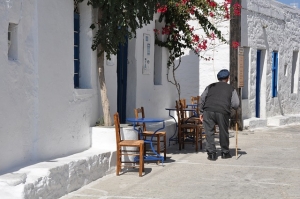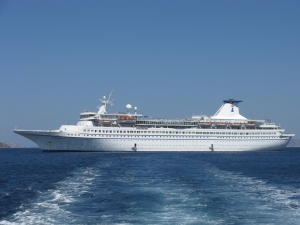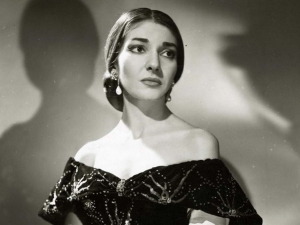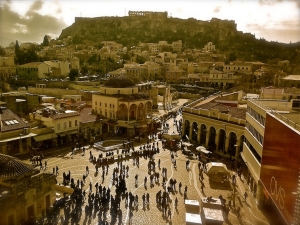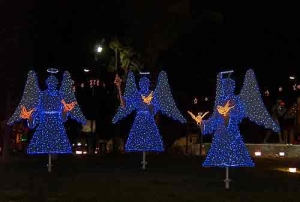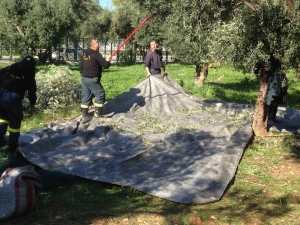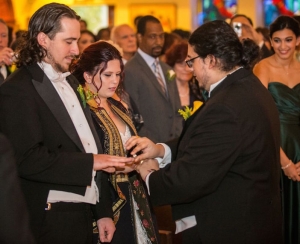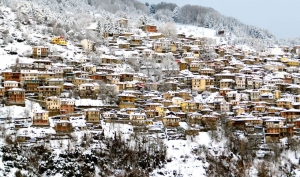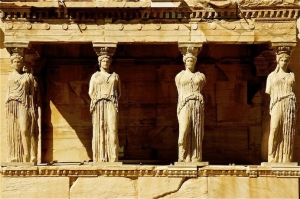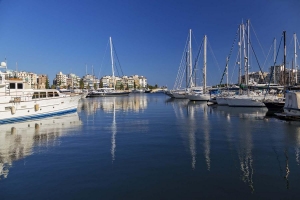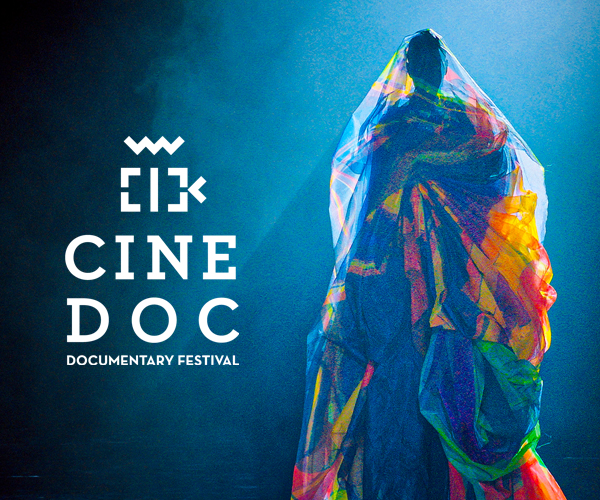LIFE & CULTURE
XpatAthens
Thursday, 17 May 2018 07:00
What Greek Wisdom Can Teach Us
The Greeks have one of the oldest cultures in the world (not to mention the first known democracy), and to this day, we turn to the wellspring of Greek wisdom for guidance on living well. With both an ancient tradition of introspection and ethical inquiry, and also to one of the most heart-healthy diets in the world, the Greeks know a thing or two about how to live a good life.
But it's not just ancient Greek philosophers like Plato and Aristotle who unlocked the secrets to a meaningful life. The health habits and leisure rituals of modern Greece also have a lot to teach the rest of the world about health and happiness. Here are some Greek secrets to living well!
1) A Healthy Mediterranean Diet
The Mediterranean diet is heavy on vegetables, olives, healthy fats and oils, fish, whole grains and red wine (in moderation), and is thought to have extensive health benefits, contributing to lower rates of heart disease, obesity, cancer and Alzheimer's disease. Research analyzing 1.5 million healthy adults found that those who followed the Mediterranean diet had a lower risk of dying from heart disease and cancer and had a reduced risk of developing Alzheimer's disease.
The Mediterranean diet is heavy on vegetables, olives, healthy fats and oils, fish, whole grains and red wine (in moderation), and is thought to have extensive health benefits, contributing to lower rates of heart disease, obesity, cancer and Alzheimer's disease. Research analyzing 1.5 million healthy adults found that those who followed the Mediterranean diet had a lower risk of dying from heart disease and cancer and had a reduced risk of developing Alzheimer's disease.
2) Take Naps
Greeks firmly believe in many things and afternoon naps are one of them. In some of the smaller towns and villages, businesses commonly shut down in the mid-afternoon for the Greek siesta time and open again around 5 p.m.
3) Appreciate the value of a good walk
During the warmer months, small villages and towns in Greece turn to the daily tradition of 'volta' (translated as stroll or outing). When the sun goes down, Greek families will take leisurely walks up and down the main streets of small towns and on the islands, they'll enjoy a leisurely stroll along the shore.
4) Ask The Big Questions
The Greek philosophical tradition is one of the oldest and arguably the richest in the world. Philosophical inquiry thrived in the culture of ancient Greece, and philosophers like Plato, Aristotle, Plotinus, Epicurus and Epictetus asked the big questions: How do we live a good life? How should the city be governed? What is morality and how should we treat others?
In many ways, we owe the tradition of living the 'examined life' to the ancient Greeks. As Aristotle once wrote, 'Knowing yourself is the beginning of all wisdom.'
5) Take Hospitality And Generosity Very Seriously
Greek hospitality goes as far back as Odysseus and it's been embedded in Greek culture and families to this day. This generosity and welcoming spirit derives from the word filoxenia which literally translates to 'love of foreigners.' Historically, it has referred to the hospitality of villagers and residents of small towns who would take in travelers passing through, offering a meal and a bed, whereas now it generally refers to the hospitality offered to friends, family or acquaintances.
To read this article in full, please visit: Huffington Post
Published in
Greek Language & Culture
Tagged under
Monday, 21 December 2015 07:00
Cruise Companies Set Sights On New Greek Destinations
Good news for 2016!
The islands of Milos, Samos, Ios, Syros, Chios, Symi and Kos are scheduled to be included in cruise itineraries for the following year in efforts to win over the rapidly growing cruise market, local media reports.
In this direction, the Shipowners Association of Cruise Ships and Shipping Agencies is currently in talks so that investments and plans for the further development of relevant infrastructure is in place in order to cater to large capacity incoming luxury liners.
Projects at the ports of Patra, Corfu, Katakolo, Igoumenitsa, Patmos, Chania, Rethymnon and Heraklion are already in the pipeline, and companies are looking to include a large part of the eastern Peloponnese among their new destinations.
To read more, please visit: Greek Travel Pages
Published in
Local News
Tagged under
Friday, 18 December 2015 17:02
What You May Not Know About Maria Callas
This month (December), Maria Callas would have been 92 years old, and almost four decades after her death, the Greek American opera singer still commands the news and media. At her peak, Callas was one of the most famous and written about women in the world.
Callas was born Maria Kalogeropoulos in New York City in 1923 to Greek immigrant parents. She impressed many as a child singer and pursued her training when her family returned to Greece. She began singing professionally in 1941 and was soon performing in major opera houses throughout the world.
Her voice is considered as one of the most dynamic in operatic history.
She died in Paris in 1977 at age 53 following a heart attack, but her persona and legendary status as a diva on and off the stage is entrenched in the public’s persona until this day.
To commemorate her 90th birthday two years ago, The Los Angeles Times published five extraordinary rumors about the soprano that have never been confirmed — nor denied. Follow are a couple of these:
1) She bore a son with Aristotle Onassis, but the child died soon after birth. Though she is believed to have been infertile, Callas was rumored to have had a love child with Onassis, the shipping tycoon and a Greek compatriot. The son was born in 1960, the rumor has it, and died hours later. Other rumors state that she had at least one abortion while she was with Onassis. Her relationship with the multimillionaire was stormy, as he is believed to have been compulsively unfaithful.
2) Callas continued her affair with Onassis during his marriage to Jacqueline Kennedy.Onassis left Callas to marry the widowed Jacqueline Kennedy in 1968. But it was widely believed that Callas continued her liaison with Onassis well into his marriage with the former first lady. “Greek Fire,” Nicholas Gage’s 2000 book about their love affair, portrays Onassis banging on Callas’ door, begging to be let back in.
1) She bore a son with Aristotle Onassis, but the child died soon after birth. Though she is believed to have been infertile, Callas was rumored to have had a love child with Onassis, the shipping tycoon and a Greek compatriot. The son was born in 1960, the rumor has it, and died hours later. Other rumors state that she had at least one abortion while she was with Onassis. Her relationship with the multimillionaire was stormy, as he is believed to have been compulsively unfaithful.
2) Callas continued her affair with Onassis during his marriage to Jacqueline Kennedy.Onassis left Callas to marry the widowed Jacqueline Kennedy in 1968. But it was widely believed that Callas continued her liaison with Onassis well into his marriage with the former first lady. “Greek Fire,” Nicholas Gage’s 2000 book about their love affair, portrays Onassis banging on Callas’ door, begging to be let back in.
To read this article in full, please visit: Pappas Post
by Gregory Pappas
Published in
People
Tagged under
Monday, 04 January 2016 07:00
24 Hours In Central Athens
The fascinating and maddening metropolis of Athens, bounded on three sides by Mount Hymettus, Mount Parnitha and Mount Pentelicus, apart from Parthenon’s 2500-year-old honey-color marble columns, has much more to offer.
If you have only 24 hours to explore Athens, the beautiful Greek capital city where tradition is exceptionally juxtaposed with modernity, here is a great way to spend the day.
9 a.m: Breakfast at Athinaion Politeia
The view of the Acropolis suffused with the light of the morning sun’s rays is the best starting point for a fascinating sightseeing tour of the city center. The neoclassical café Athinaion Politeia is the best place to taste the flavors of an original Greek breakfast. Address: Athinaion Politeia, 1 Akamantos & Apostolou Pavlou, Thiseio, Athens
11 a.m: Monastiraki Square for a Jumble of Curios
Abandon yourself in the disparate colors, scents and sounds of the labyrinthine corners of an area that is nestled under the ancient Acropolis. Browse among the secondhand books, haggle over the price of the antiques, wander through the open-air market stores and try a souvlaki at Bairaktaris Restaurant. Address: Bairaktaris, 63 Metropolis & 88 Metropolis, Monastiraki, Athens
1 p.m: A stroll down Ermou and Mitropoleos Street
Well-frequented shops, cafes, street vendors and artists crown the length of Ermou Street. Mitropoleos Street, on the other hand, is a jewel among the architectural creations of the 20th century.
3 p.m: Acropolis on your plate
Visiting the Acropolis Museum Restaurant, you can enjoy panoramic views of the Acropolis and the historic hills of Athens. The restaurant offers a great variety of tasty dishes that are based on authentic Greek recipes.
Opening hours: Monday to Thursday: 9:00 a.m. – 5:00 p.m., Friday: 9:00 a.m. – 10:00 p.m. (every Friday the restaurant remains open until 12 midnight), Saturday and Sunday: 9:00 a.m. – 8:00 p.m.
To read more, please visit: Greek Reporter
by Katerina Papathanasiou
Published in
City Discovery
Tagged under
Thursday, 17 December 2015 07:00
Athens One Of The Most Popular Christmas Destinations
Athens is one of the most popular European Christmas destinations. In specific, the Greek capital ranks 24th in preferred destinations among foreign tourists, beating out other European destinations. The first places are occupied by London, Paris, Berlin and Rome.
Athens, despite being one of Europe’s most popular destinations, is also one of the cheapest with hotel rates averaging about 74 euros a night during the Christmas period. In order to attract tourists from new markets in Europe during the winter period, Athens’ International Airport along with Marketing Greece, have started a new promotional campaign entitled “Speak Aθenian. Be an Aθenian,” to promote Athens as a destination.
To read more, please visit: Greek Reporter
by Toni Aravadinos
To read more, please visit: Greek Reporter
by Toni Aravadinos
Published in
Greece In The News
Tagged under
Wednesday, 16 December 2015 07:00
Greek Volunteers Harvest Olives For Fellow Residents In Need
As olives were harvested this fall to be prepared for the massive olive oil production that takes place throughout Greece, a special harvest took place in the municipality of Glyfada, involving a humanitarian effort by the city and volunteers to provide olive oil to people in need.
Like most of Greece, olive trees are abundant on public land and go largely untouched, with tons of fruit simply withering and falling to the ground, season after season. One resident - Stavros Giakoumakis - wanted to change that and approached Glyfada's mayor, Giorgos Papanikolaou, with a plan.
That plan involved a massive volunteer and educational effort to harvest all of the olive trees that exist on public land; parks, forested areas and other areas that belong to the municipality, and produce olive oil that would, in turn, be given to needy familie through the city's public welfare efforts.
To read more, please visit: Pappas Post
.
Published in
Local News
Tagged under
Tuesday, 15 December 2015 07:00
Remarkable Story Of One Bride's Wish To Honor 5 Generations Of Greek Women With Century-Old Wedding Coat
A great grand-daughter born in New York and a great-grandmother born a world and four generations back in Turkey - connected by a wedding coat. This is the beautiful story of Evangelia Tsaoussis and her desire to pay tribute to four generations of her family's Greek heritage.
Ever since Evangelia (Eva) first laid eyes on her Yiayia Eliso's wedding coat, she felt a connectiont to it. Yiayia Eliso was her great-grandmother, her 'little yiayia' who was both as tall and as tiny as Eva was. And although they were born a world apart and in different eras, more than a century apart - growing up little Eva felt a special bond with her great grandmother.
Both were born with the same attitude and thirst for life as the other, that same underlying love of family and fierce survivor attitude. Eva and her great-grandmother were very close, Yiayia Eliso passed away at the age of almost 100, leave Eva with a full lifetime of memories.
Yiayia Eliso was born Elizabeth Bantos in the early 1900s in the historic Phanar district of then Constantinople to parents who fled from Pontos and walked for days to reach safety. It was the time in the late 1800s and early 1900s when life for Greeks in Asia Minor was volatile and dangerous.
Yiayia Eliso’s mother Vasiliki was given a traditional Greek wedding coat by her mother, taking the story of this embroidered jacket back five generations. With the help of a Turkish Imam in Constantinople, Eliso’s family was helped with safe passage to Epirus in mainland Greece, where they stayed for a few years, before heading to Athens, where the family settled.
All along the way, the wedding coat that was with the family for generations was amongst the most precious cargo when the family resettled from one place to another. Eva’s family tree is the stuff legends are made of— having survived the massacres and genocide of the Greeks of Pontos, migration from Constantinople to mainland Greece, both world wars, the occupation, the civil war and subsequent expulsion from their homeland, eventually arriving in America as refugees, where Eva’s mother Liz (named after yiayia Eliso), was born.
Liz grew up in New York’s close-knit Greek American community. She eventually married and had two children— Eva, and a son George. She instilled in both of her children a love of faith, culture and community service and always shared stories of her rich family history and heritage. So when Eva matured and it was time for her to get married— it was only natural that she honor her family— and the memory of her great grandmother with whom she shared so much— by donning the family wedding coat.
To read more, please visit: Pappas Post
Published in
People
Tagged under
Monday, 11 December 2017 07:00
What To Do In Greece During The Christmas Holidays
What to do in Greece during the Christmas holidays!? Fortunately, Greece is a terrific place to be at anytime during the year and especially during the Christmas holidays.
Hopefully you have a few days to experience some of the great ideas that we've suggested for you below. All of these ideas are great for the whole family, with friends or if you're traveling solo.
Find A Great Bakery Or Drop In At A Friend's House
Christmas in Greece brings many traditions from different parts of the country, but one tradition that is the same everywhere is all the great desserts! Visit a Greek friend's house during the holidays or a local bakery to try some of these traditional Christmas flavours:
Melomakarona - traditional Christmas cookies with delicious Greek honey.
Kourabiedes - traditional Christmas cookies covered in white powedered icing sugar.
Orange Cake - oranges are in season during the winter in Greece and many traditional recipes call for orange.
Diples - thinly folded pastry drizzled lightly with yummy Greek honey.
Vasilopita - traditional sweet bread baked for new years day.
Hopefully you have a few days to experience some of the great ideas that we've suggested for you below. All of these ideas are great for the whole family, with friends or if you're traveling solo.
Find A Great Bakery Or Drop In At A Friend's House
Christmas in Greece brings many traditions from different parts of the country, but one tradition that is the same everywhere is all the great desserts! Visit a Greek friend's house during the holidays or a local bakery to try some of these traditional Christmas flavours:
Melomakarona - traditional Christmas cookies with delicious Greek honey.
Kourabiedes - traditional Christmas cookies covered in white powedered icing sugar.
Orange Cake - oranges are in season during the winter in Greece and many traditional recipes call for orange.
Diples - thinly folded pastry drizzled lightly with yummy Greek honey.
Vasilopita - traditional sweet bread baked for new years day.
Head To Kaimaktsalan & The Pozar Thermal Springs
This is a terrific combination for skiing and swimming! One day you can go skiing on the mountain of Voras (Kaimaktsalan), stay in the village of Old Agios Athanassios, and the next day (or even the same day) you can visit the Thermal Springs of Pozar. If you're feeling adventurous, you can even hike along the river at Pozar too.
The ski center at Kaimaktsalan is very big, well organized and fun for the whole family. You may also want to rent a snow-bike and ride to the top where an ice church covered with snow stands. This church was constructed by soldiers - entirely build from war material, even bomb shells and barbwire.
Feeling a bit sore? Within 1 hour (or 1.5hrs if foggy) you can soak your body in the hot healing waters of Pozar (with temperatures nearing zero degrees). Feeling a bit risky? Try the hot/cold combination. Next to the thermal poll, there's a freezing waterfall that pours its waters over you. The benefits for the body are superb.
Visit The Waterfalls Of Edessa
As you leave Kaimaktsalan, do not forget to pass through the city of Edessa. There you will find the waterfalls located inside the city and it's a magnificent spectacle. You can even cross the narrow path that goes behind the waterfall - a great photo opportunity. Try walking to the waterfall base, then look up!
Explore The Dream City Of Drama
Drama is a city within a city and is a dream for adults and children alike. The city comes alive at this time of year with many traditional festivities from December to January. In addition to the whole city being decorated for the season, there are many cultural events and programs to enjoy for the whole family. Drama is close to many other great towns and villages to discover in norther Greece, so make sure that you book a couple days to make the most of discovering the area.
To read this article in full, please visit: A Greek Adventure
Published in
Travel Greece
Tagged under
Monday, 14 December 2015 07:00
Greek Government Changes Course On Parthenon Marbles
Greece is no longer mulling court action to win back the Parthenon Marbles from the British Museum in London, Culture Minister Aristides Baltas said Tuesday, adding that the government would kick-start a diplomatic campaign to repatriate the 5th century BC statues.
Questioned by MPs during a session of Parliament’s education committee, Baltas said that the government was unwilling to put forward a legal claim “most importantly because we risk losing the case.”
The committee met to discuss a European Council directive on the return of cultural objects unlawfully removed from the territory of a memberstate.
The leftist minister said that lawyer Amal Clooney and the Doughty Street Chambers legal team from London, who had been advising Athens on possible action in the international court to force the British Museum to hand over the Marbles, had already been compensated for their services.
To read more, please visit: ekathimerini
Published in
Local News
Tagged under
Monday, 14 December 2015 07:00
East Med Yacht Show 2016 To Spotlight Piraeus
The Marina Zea in Piraeus is getting ready to hold the 15th East Med Yacht Show in 2016 and welcome international charter professionals, private yacht brokers and travel agents to give a broad display of over 60 Greek luxury crewed yachts for charter.
After being held for many years in the docks of Poros Island, the event was decided to be held between May 13 and May 18, 2016, in the Marina Zea in the port city Piraeus, one of the largest ports in the world.
In a press conference, Piraeus Mayor Yiannis Moralis underlined the importance of the yacht show for the city's exposure.
“Industry professionals, travel agents, residents and the thousands of visitors that will visit the yacht show will have the opportunity to get to know the attractions and beauties of Piraeus”, Mayor Moralis said and added that the yacht show’s location — Marina Zea — is one of the most impressive spots in Piraeus.
The Municipality of Piraeus will support the yacht show through its ongoing tourism campaign “Destination Piraeus”. All participants and guests at the show will have the chance to get to know the city through the campaign’s apps for smartphone and tablets that support a number of languages.
“Industry professionals, travel agents, residents and the thousands of visitors that will visit the yacht show will have the opportunity to get to know the attractions and beauties of Piraeus”, Mayor Moralis said and added that the yacht show’s location — Marina Zea — is one of the most impressive spots in Piraeus.
The Municipality of Piraeus will support the yacht show through its ongoing tourism campaign “Destination Piraeus”. All participants and guests at the show will have the chance to get to know the city through the campaign’s apps for smartphone and tablets that support a number of languages.
To read more, please visit: Greek Travel Pages
Published in
Greece In The News
Tagged under

